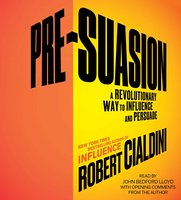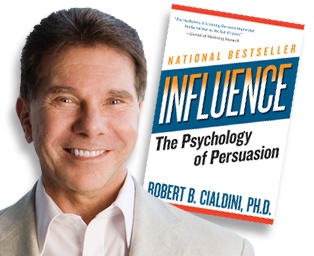 “Tell me what you are paying attention to; and I will tell you who you are” ~ José Ortega y Gasset
“Tell me what you are paying attention to; and I will tell you who you are” ~ José Ortega y Gasset
Dr. Robert Cialdini, author of Influence: The Psychology of Persuasion and most recently, Pre-suasion, offered this quote as a key element to pre-suade your prospect before you present your message.
How do you accomplish this?
By Temporarily changing what People view as important!
Proof?
Pre-saude
Cialdini shared a research study of online shoppers. Furniture shoppers were sent to two different websites. One had fluffy clouds as images floating in the background, another pennies. Both website sold sofas. The results may not startle you as much as what the purchasers indicated after their purchase.
Those shoppers who were sent to the fluffy clouds site showed:
- Assigned greater levels of importance to comfort
- Searched the site for comfortable features of sofas
- Ultimately lead them to purchase more
Those with the pennies in the background:
- Elevated their level of interest in price
- Searched more for lower priced items
- Chose less expensive furniture
Neither recognized the pennies or clouds had any influence on their decision-making.
What’s background on your landing page?
Cialdini offered “If it’s not important to your most important aspect of your business, it’s not doing the job it should.”
Influence: The Psychology of Persuasion
 Dr. Robert Cialdini, has been to several of our previous Growth Summits. If you’re not familiar with his first book, I urge you to read it. Cialdini reviewed the Six Universal Principles of Social Influence shared previously in my blogs (Cialdini offered additional insights):
Dr. Robert Cialdini, has been to several of our previous Growth Summits. If you’re not familiar with his first book, I urge you to read it. Cialdini reviewed the Six Universal Principles of Social Influence shared previously in my blogs (Cialdini offered additional insights):
- Reciprocation: (There is no culture that doesn’t follow this rule. Do me a favor, results in I owe you a favor – people say yes to those they owe.) You have to go first. Rule installed by parents, teachers, etc., smile at person, get a smile in return, only get smile if you go first. (nasty names for people who don’t follow this rule, moochers, vagrant, teenagers, etc.,) People felt obligated.
- Liking (How to do it – identify commonalities between people. Study showed when negotiate by email [30% no agreement]. When you do something first, provide information about yourself, your school, hobbies, family. Deadlocks in negotiations dropped from 30% to 60%. When you humanize yourself to the other person, people identify with real similarities, and everything gets better.)
- Consistency (This works especially in public with what people say and do. No Shows at doctor or dentist office, decrease with just a small change. At end of last medical appointment, you’re provided with a new time on a card. The Change: Instead of having the nurse complete it; slide a blank card and pen, ask the person to write down the time and date. This actively engages them. Simple change induces an 18% reduction in no shows. At Gordon’s Restaurant, Chicago. Receptionist took order, then said, please call if you have to cancel or change your reservation. Two Word Change. Instead of please call, “Will you please call, (PAUSE)?” No shows dropped by 67% for two more words. Two words that get people to be consistent with their behavior.
- Authority (We want to say yes to experts. Establish yourself as expert. Budget or price to get approve. $75,000 vs $75,123. More likely to say yes if it’s a precise number vs. rounded. Realize you’ve done your homework. You’re an authority, worked hard to get that number. Research shows more likely to say yes to it even if it’s more money. In Homework or tests, when you show me your work, it shows proof you know you understand the question/work.
- Consensus (Follow the lead of those around them, be like them. In Beijing, China, owners of string of restaurants, put asterisk items on menu (Most popular items) 15-20% increase for being most popular. Reduce uncertainty on what people should do. Point to popularity.
- Scarcity (People want more of those things there are less of. In stores, limit 3 per customer, Result: Doubled purchases. Legitimate constraints, needs to go to the top of the presentation. Want it more because they’re unique or have dwindling availability.)
The key Cialdini shared is to be a detective. Recognize when one of these principles is at work in the situation you are in to take advantage of it.
PRE – SUASION
How do you use pre-suasion principles?
Cialdini’s definition of PRE – SAUSION: process of arranging for recipients to be sympathetic to your message before they experience it.
KEY: Know your message. Arrange for your prospect/people you’re attempting to influence, to be aligned with the central element of your message.
Not in the message, but in the moment before your message.
What we’re directed to first makes us put greater importance on it. Cialdini provided several examples of where the name of a street, the location of a flower shop influenced men and woman to respond much differently.
Pre-suaders increase agreement with a yet-to-be -delivered message in 2 ways:
1. IDENTIFY THE PRECISE GOAL OF YOUR MESSAGE (WHAT IS A SPECIFIC RESULT YOU WANT?)
2. CREATE A MINDSET CONSISTENT WITH THAT GOAL VIA:
- Words
- Situations
- Images
MORE PRE – SAUSION IDEAS - NEXT BLOG
Is there a time of the week or month your organization is more open to change? Will your team be more likely to perform better as a unit if they see images of people working together? The answer to both these questions is a resounding yes! More for the master of influence, Robert Cialdini, next blog.






.jpeg?width=150&height=135&name=Hand%20with%20marker%20writing%20the%20question%20Whats%20Next_%20(1).jpeg)

